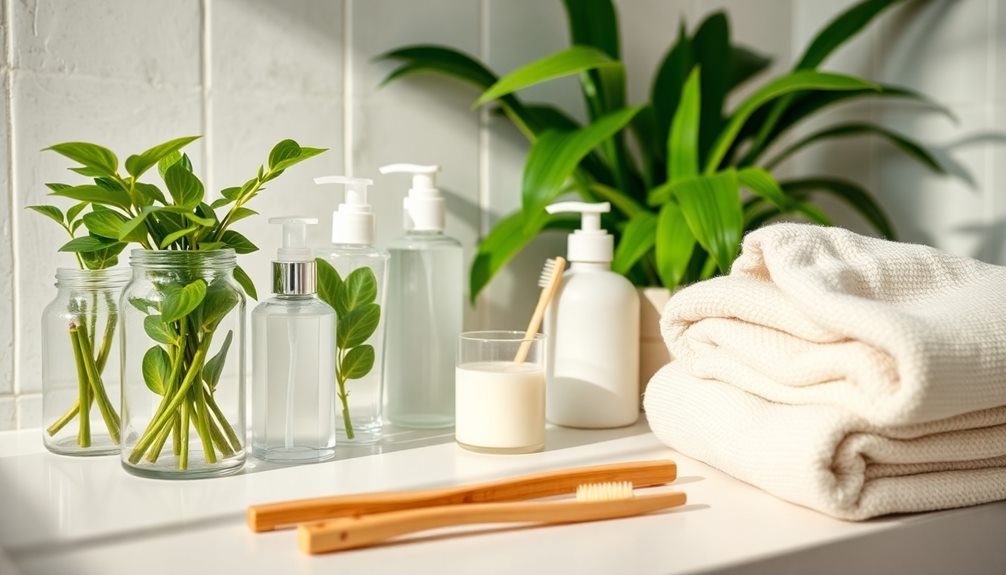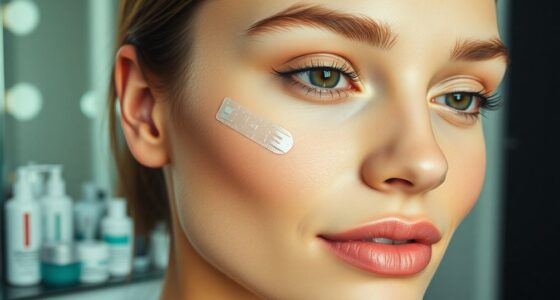Sustainable beauty means choosing clean products that care for your health and the planet. You can look for items made with responsibly sourced, biodegradable ingredients, avoiding harmful additives. With 76% of consumers prioritizing sustainability in 2023, brands are innovating with refillable packaging and ethical ingredient sourcing. Transparency is key; you want proof that a product is genuinely eco-friendly. While higher prices can be a hurdle, understanding the value behind these choices can help. By exploring sustainable beauty options, you'll discover how effective and conscious your beauty routine can be, revealing a world of eco-friendly possibilities.
Key Takeaways
- Sustainable beauty prioritizes health and the environment, focusing on responsibly sourced, biodegradable ingredients and avoiding harmful additives.
- Transparency in sourcing and production is essential to combat greenwashing and build consumer trust.
- Refillable and eco-friendly packaging innovations, like zero-plastic glitter, reduce plastic waste and appeal to conscious consumers.
- Ethical ingredient sourcing, including fair trade practices and upcycled ingredients, enhances sustainability and supports local communities.
- Effective communication strategies, such as clear labeling and justifying pricing, foster consumer loyalty and confidence in sustainable products.
Understanding Sustainable Beauty
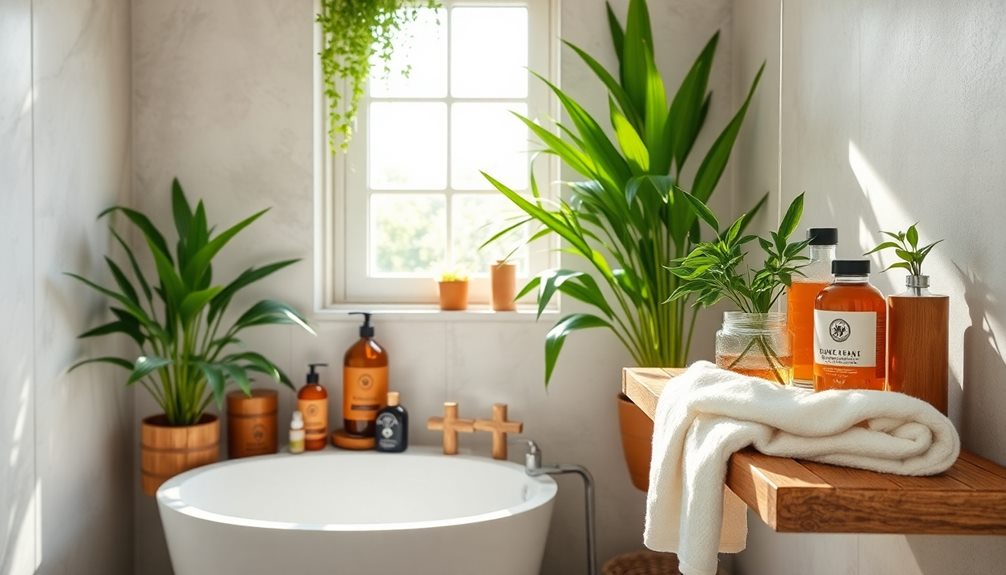
Understanding sustainable beauty means recognizing how your choices impact both your health and the environment. When you opt for clean beauty products, you're not just caring for your skin; you're also considering the ingredients and their sourcing.
Sustainable beauty emphasizes responsibly sourced, biodegradable ingredients while avoiding harmful additives. This approach promotes your personal health and the well-being of our planet. Additionally, maintaining a healthy skin routine, including hydration vital for skin health, is key to enhancing the benefits of these products.
As a consumer, you're part of a growing movement—about 76% of you're actively seeking sustainable products in 2023. This shift reflects an increasing awareness of the environmental impact of beauty products.
However, the clean beauty industry can be tricky, with potential greenwashing lurking behind unregulated claims. It's important to seek transparency in ingredient sourcing and production practices to make informed choices.
Moreover, many clean beauty brands focus on eco-friendly packaging to reduce plastic waste. Innovations like refillable solutions and recyclable materials play an important role in minimizing the beauty industry's staggering 120 billion units of packaging produced annually, of which 70% ends up in landfills.
Key Trends in Clean Products
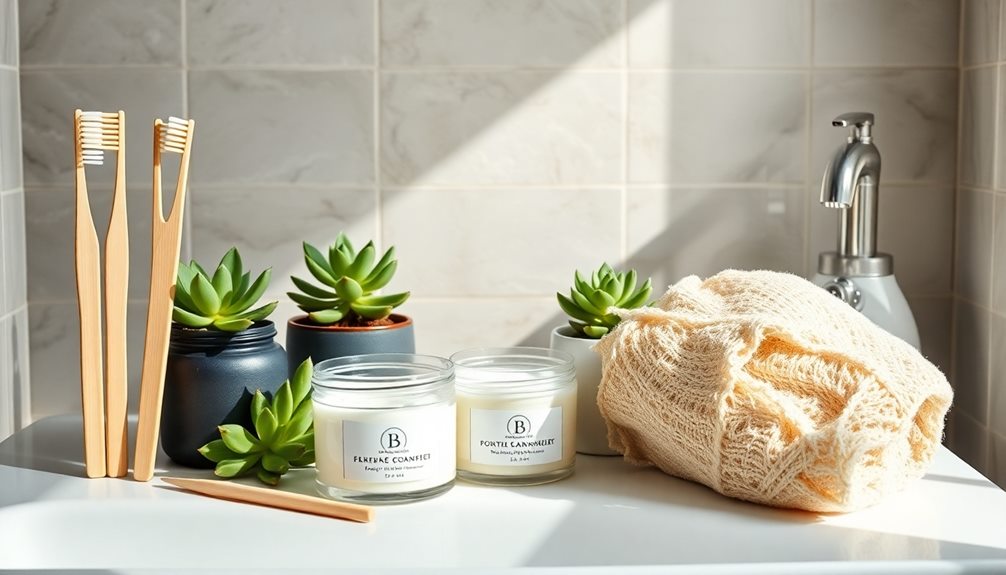
As the beauty industry evolves, key trends in clean products are shaping how you choose and use beauty items. In 2023, a remarkable 76% of consumers actively seek sustainable products, reflecting a shift towards eco-conscious purchasing behaviors.
Sustainable beauty brands are responding by emphasizing clean skincare that prioritizes ethical ingredient sourcing, including the use of essential oils for skin health to enhance natural beauty. Additionally, these brands are also taking a stand against harmful chemicals and incorporating natural skincare preservatives to extend the shelf life of their products without compromising the safety or efficacy. By promoting transparency and environmentally-friendly practices, sustainable beauty brands are gaining the trust and loyalty of conscientious consumers who want to feel good about the products they use on their skin. Through their commitment to ethical sourcing and clean formulations, these brands are setting a new standard for the beauty industry.
You'll notice a growing number of products featuring refillable containers, which are becoming essential in reducing waste. In the UK, 9% of beauty launches in 2022 highlighted refill claims, showcasing the industry's commitment to sustainable packaging.
Brands that offer lower-priced refills are particularly appealing to budget-conscious consumers, especially in markets like Germany, where price is a significant barrier.
Additionally, innovative packaging solutions, such as zero-plastic glitter, demonstrate a dedication to eco-friendly practices. More brands are also adopting ethical ingredient sourcing; for instance, Tarte supports female empowerment through cooperative farming, while REN Clean Skincare is actively removing ocean plastic.
Overcoming Barriers to Adoption
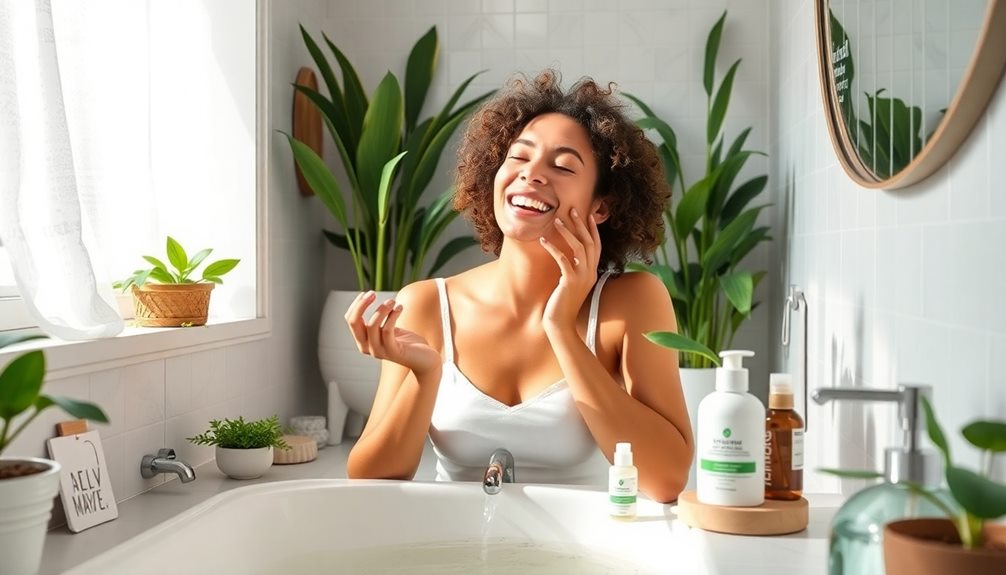
You might find that price sensitivity and trust issues are major hurdles when considering sustainable beauty products. Many consumers hesitate to spend more without clear proof of a brand's eco-friendliness, making transparency essential.
By embracing challenges as opportunities for growth, brands can better understand consumer concerns and tailor their messaging accordingly. Additionally, personal growth techniques can encourage companies to cultivate deeper connections with their audience.
Addressing these concerns can help brands build loyalty and encourage more people to embrace sustainable options.
Price Sensitivity Challenges
Consumers' price sensitivity presents a significant challenge for the adoption of sustainable beauty products. In Germany, over 50% of non-buyers cite high prices as a major barrier, pushing many to prioritize lower-cost options over premium clean beauty brands. This financial constraint means that you might often overlook sustainable products, even when you want to support eco-friendly initiatives.
To bridge this gap, brands need to combine sustainability with value, like offering lower-priced refills or budget-friendly options. These strategies can't only enhance loyalty but also attract consumers who are cautious about spending.
Additionally, the perception of inconvenience around recycling programs contributes to hesitance. Improving consumer education around these programs can help ease your concerns and encourage adoption.
However, the prevalence of greenwashing complicates the situation. With misleading claims about eco-friendliness, it becomes difficult for you to trust clean beauty brands. Transparent, proven claims are essential to overcoming these price sensitivity challenges and ensuring that you feel confident in your choices.
Trust and Transparency Issues
Maneuvering the sustainable beauty market can feel overwhelming, especially when trust and transparency issues arise. Over 65% of adults in the UK struggle to verify the eco-friendliness of brands, revealing a critical need for clear communication.
When you're faced with high prices and the fear of greenwashing, it's no wonder that over 50% of German consumers hesitate to buy natural products.
To overcome these barriers, brands must prioritize transparency. Implementing effective communication strategies, like on-pack traffic light systems, can clarify sustainability claims and empower you to make informed choices.
You'll feel more confident when brands provide traceable proof of their eco-friendly attributes, such as ingredient sourcing and packaging recyclability.
Ultimately, fostering consumer engagement and trust is essential for driving the adoption of sustainable beauty products. When brands commit to genuine transparency, they can combat the negative effects of greenwashing and enhance your overall experience.
As a conscious consumer, you deserve to know the truth behind the products you use. By demanding clarity and supporting brands that prioritize trust, you can help reshape the sustainable beauty landscape.
Consumer Trust and Transparency
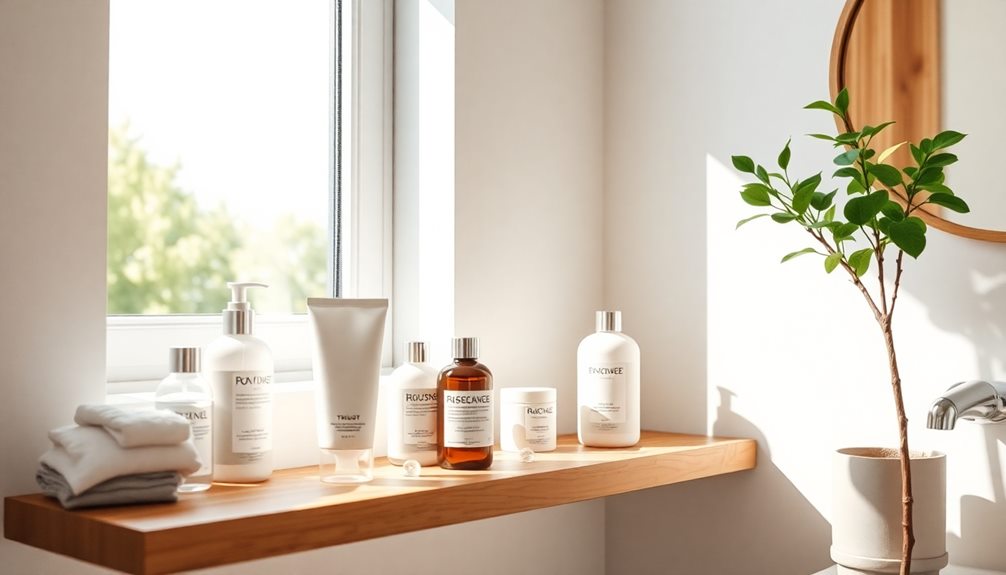
In today's crowded marketplace, trust plays an essential role in how consumers perceive sustainable beauty products. You're not alone in wanting clarity; over 65% of adults in the UK find it tough to verify a brand's eco-friendliness. This highlights a significant need for transparency in labeling and communication.
Brands that embrace clear, straightforward messaging can help ease your concerns about their sustainable practices and justify those higher price tags.
Many consumers prefer on-pack traffic light systems, which simplify understanding the eco-friendly aspects of products. This illustrates your demand for transparent labeling that cuts through the noise of greenwashing.
Unfortunately, misleading eco-claims can severely diminish consumer trust, prompting legal actions and new EU legislation aimed at combating these deceptive practices.
When brands effectively engage you with honest messaging about their sustainability efforts, they bolster your trust and loyalty.
The path to a more sustainable beauty industry lies in brands being open about their clean products and the performance behind them. By fostering transparency, they can create lasting relationships with conscious consumers like you, ensuring you feel confident in your choices.
Effective Communication Strategies
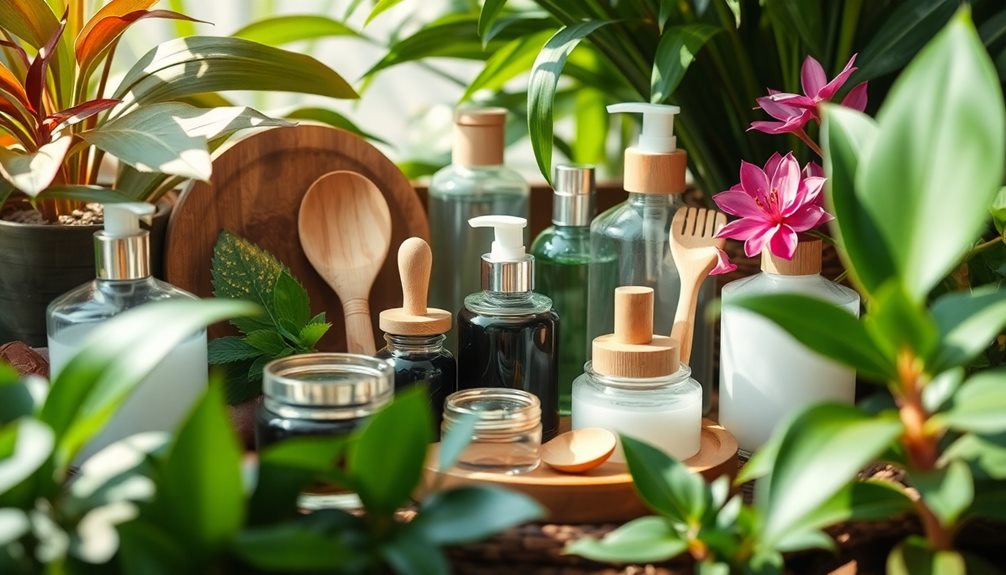
When you're shopping for sustainable beauty products, clear and transparent messaging really matters.
You want brands to simplify sustainability, making it easy to understand what eco-friendly claims mean. Engaging communication that highlights both effectiveness and eco-consciousness can help you feel confident in your choices.
Transparent Messaging Importance
Transparent messaging is essential for brands working to thrive in the clean beauty market. As consumers become more environmentally conscious, they expect clear communication about eco-friendly practices.
To build consumer trust and loyalty, consider these effective strategies:
- Clear Labeling: Use straightforward, on-pack traffic light systems to simplify sustainability claims, making it easier for consumers to make informed choices.
- Traceable Proof: Provide verifiable information about your sustainable products, as 65% of adults find it challenging to confirm a brand's eco-friendliness.
- Engaging Communication: Craft messages that highlight the benefits and effectiveness of your products, as nearly 50% of clean product users prioritize performance when purchasing.
- Justify Pricing: Clearly explain why sustainable products may cost more, emphasizing their quality and effectiveness to reassure consumers.
Simplifying Sustainability Understanding
Building on the importance of transparent messaging, simplifying sustainability understanding can greatly enhance consumer engagement. You may find that on-pack traffic light systems make it easier to navigate the world of clean products.
With over half of UK adults believing companies should prioritize sustainability, these visual cues can help you make informed choices at a glance.
In a crowded market, transparent messaging is crucial. As a consumer, you likely want brands that justify their higher price tags with proven eco-friendly attributes and product performance.
Yet, with 65% of adults struggling to verify a brand's eco-friendliness, clarity becomes essential. Clear, traceable proof of sustainable practices and ingredient safety can help you feel secure in your purchasing decisions.
Furthermore, leveraging familiarity with nutrition scores from food can create a similar understanding in beauty products. This approach helps you navigate eco-friendly claims more effectively, enhancing your trust in brands.
Engaging Eco-Friendly Communication
Effective communication is essential in the quest for sustainable beauty, as it bridges the gap between consumer expectations and brand promises.
With more than 65% of adults finding it hard to verify eco-friendliness, transparent messaging is crucial for building trust in sustainable brands.
To enhance consumer engagement, consider these effective strategies:
- On-Pack Traffic Light Systems: Use clear labeling to indicate eco-friendly attributes, simplifying choices for consumers.
- Balance Messaging: Highlight both sustainability and product efficacy, as nearly 50% of clean product users prioritize effectiveness in their purchases.
- Traceable Proof: Provide clear, traceable evidence of sustainable practices and claims to reinforce trust and credibility.
- Familiar Formats: Adapt familiar systems, like nutrition scores in food, for beauty products to help consumers easily understand your offerings.
Innovations in Packaging Solutions

Innovative packaging solutions are transforming the beauty industry, making sustainability a top priority for brands and consumers alike. You might've noticed brands like Sangre de Fruta offering refill pouches for shampoo and conditioner, which considerably reduce plastic waste. This kind of innovation not only helps the environment but also makes it easier for you to enjoy your favorite products without the guilt of excess plastic.
Moreover, Ganni x Submission Beauty's introduction of zero-plastic glitter made from eucalyptus cellulose highlights the shift towards biodegradable alternatives in cosmetics. Tata Harper's Water-Lock Moisturizer comes with a 100% recyclable refill pod, emphasizing a commitment to sustainable packaging that minimizes environmental impact.
La Bouche Rouge takes it a step further with its refillable highlighter sticks, showcasing that luxury can align with eco-friendly practices. Additionally, SOSHE Beauty's G.L.A.M. mascara features a refillable case, promoting a circular economy and earning its certified plastic negative status.
These innovations in packaging not only provide clean beauty solutions but also encourage you to make more conscious choices in your beauty routine.
Ethical Ingredient Sourcing

When you choose beauty products, consider how brands source their ingredients.
Upcycled ingredients not only reduce waste but also contribute to a more sustainable economy.
Fair trade practices and local sourcing further enhance the positive impact on communities and ecosystems, making your beauty routine a force for good.
Upcycled Ingredients Benefits
Upcycled ingredients offer numerous benefits that make them a game-changer in the beauty industry. By utilizing materials that would otherwise go to waste, these ingredients promote sustainability and ethical sourcing while enhancing product efficacy.
Here are four key advantages of upcycled ingredients:
- Environmental Impact: They reduce the need for new raw materials, minimizing resource extraction and lowering waste in landfills.
- Quality and Efficacy: Upcycled ingredients often retain high quality and beneficial properties, ensuring your beauty products are both effective and eco-friendly.
- Circular Economy: Incorporating these ingredients fosters innovation and aligns with circular economy principles, encouraging a more sustainable approach to production.
- Brand Loyalty: As consumers become more conscious about their purchases, supporting brands that prioritize sustainability and ethical sourcing strengthens brand loyalty.
Brands like Sangre de Fruta exemplify this commitment by sourcing upcycled local ingredients from the logging industry, highlighting community support along with environmental responsibility.
Fair Trade Practices
Fair trade practices are reshaping the beauty industry by prioritizing ethical ingredient sourcing that benefits both producers and consumers. Brands like Tarte and Korres exemplify this commitment by ensuring farmers receive fair wages and support for sustainable farming methods.
You'll find that companies such as Gisou take it further by prioritizing bee welfare, harvesting only surplus honey and propolis, which reflects their dedication to ethical sourcing and local ecosystems.
Moreover, brands like Sangre de Fruta showcase innovative approaches by utilizing upcycled local ingredients, reducing waste generated by the logging industry. This aligns perfectly with the principles of sustainable beauty.
Fair trade practices often encompass community empowerment initiatives, too. For instance, Lunalis sources botanicals from women-led farms in Morocco, promoting gender equity and fair wages.
As a conscious consumer, you'll appreciate that ethical ingredient sourcing not only uplifts producers but also enhances consumer trust. In fact, over half of UK beauty product launches in 2022 featured ethical claims, demonstrating a growing demand for responsible sourcing.
Local Sourcing Impact
Local sourcing of beauty ingredients not only strengthens community economies but also cuts down on transportation emissions, making it a vital aspect of sustainable beauty.
When you choose products that prioritize local sourcing, you support a more sustainable and ethical beauty industry.
Here are some benefits of local sourcing:
- Supports Local Farmers: Brands like Korres aid over 1,000 Greek farming families by sourcing ingredients from their lands, ensuring the community thrives.
- Reduces Carbon Footprint: By minimizing transportation, you help reduce greenhouse gas emissions associated with beauty product delivery.
- Enhances Freshness: Local sourcing often means fresher ingredients, leading to more effective and appealing products for clean beauty enthusiasts.
- Encourages Upcycling: Companies like Sangre de Fruta use upcycled local ingredients, reducing waste while showcasing innovative ways to achieve sustainability.
Eco-Friendly Production Methods
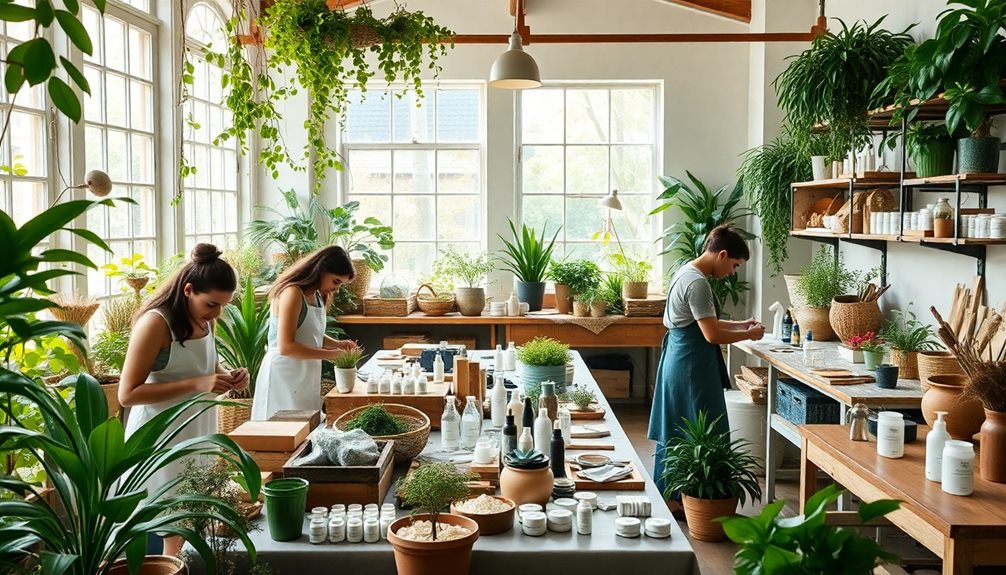
In the beauty industry, eco-friendly production methods are transforming how products are made and packaged. Brands are increasingly adopting sustainable practices that not only prioritize the environment but also enhance your beauty experience. For instance, companies like Gisou use 100% solar energy for manufacturing and offer recycling instructions for their products.
Additionally, REN Clean Skincare has repurposed 16 tons of plastic in just one year, showcasing how effective recycling can be in reducing plastic waste. Meanwhile, Tata Harper focuses on refillable products, which greatly cuts down on the need for new packaging shipments. This approach supports a circular economy by minimizing waste while providing you with a more sustainable option.
Here's a quick look at some eco-friendly production methods:
| Brand | Method | Impact |
|---|---|---|
| Gisou | 100% solar energy | Reduces carbon footprint |
| REN Clean Skincare | Innovative recycling | Repurposed 16 tons of plastic |
| Tata Harper | Refillable products | Decreases packaging waste |
| Uni | Closed-loop system | Promotes circular economy |
| SOSHE Beauty | Refillable mascara | Achieves certified plastic negative status |
These practices are paving the way for a cleaner, greener beauty industry.
Community Empowerment Initiatives
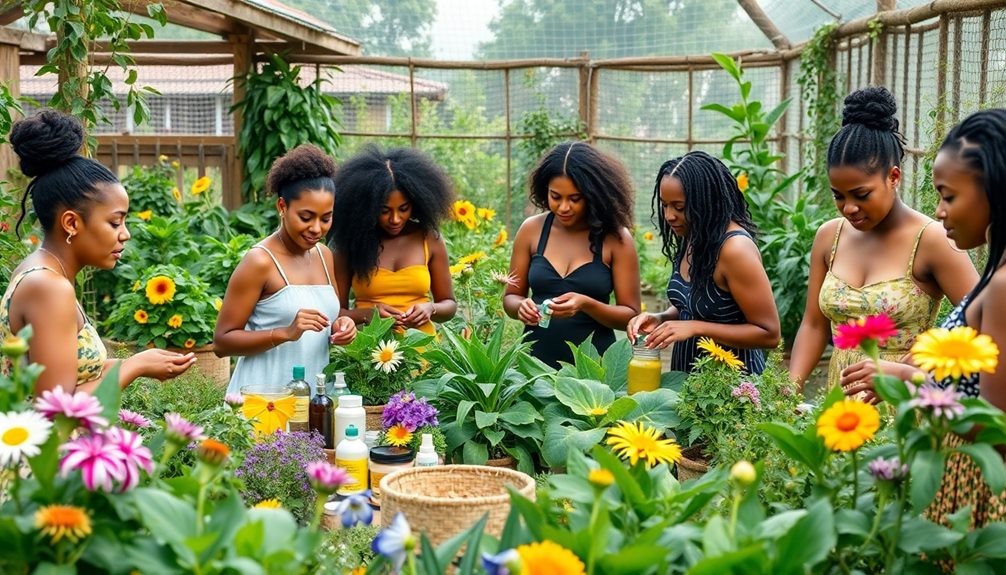
How can beauty brands make a real difference in the communities they touch? By focusing on community empowerment initiatives, they can create lasting change while promoting sustainable practices. Here are some impactful ways brands can contribute:
- Training Programs: Brands like Sana Jardin train women in Morocco to upcycle flower waste, generating job opportunities and boosting local economies.
- Fair Compensation: Salwa Petersen's brand guarantees fair wages for women harvesting organic seeds, supporting community development and conservation through partnerships like the African Parks Network.
- Sustainable Packaging: Valdée Beauty minimizes environmental impact by using packaging that avoids single-use plastics, promoting a culture of sustainability in beauty.
- Ethical Sourcing: Korres sources 100% of its plant materials from local Greek farmers, supporting over 1,000 farming families and enhancing community sustainability.
Through these initiatives, beauty brands not only provide clean products but also foster a sense of environmental stewardship.
Future Outlook for Clean Beauty
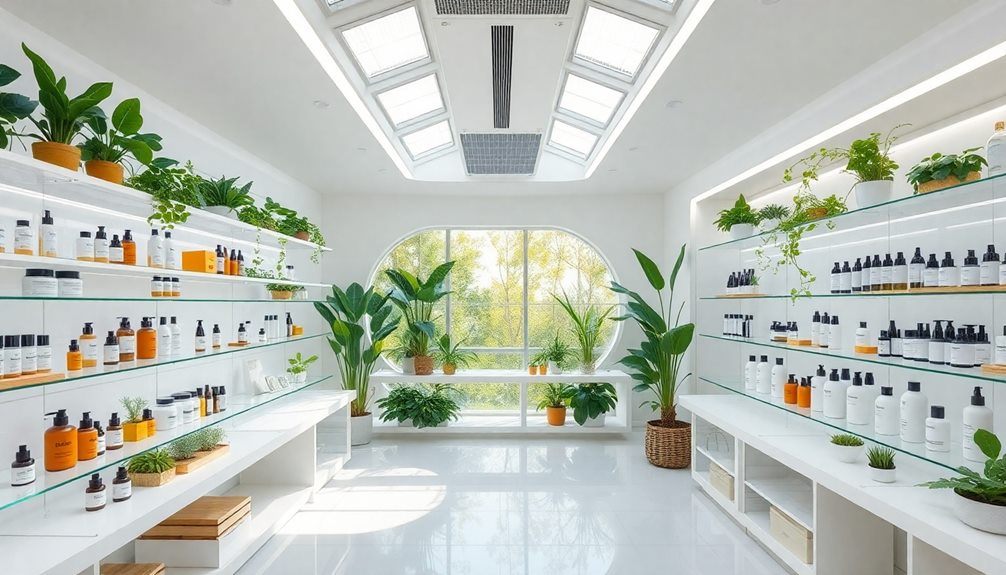
Clean beauty is on the rise, and it's reshaping the beauty landscape like never before. With 76% of consumers seeking sustainable options in 2023, you can expect a significant shift in product offerings. Brands are increasingly responding to consumer demand for eco-friendly and cruelty-free products, leading to innovative product launches.
| Trend | Impact on Clean Beauty |
|---|---|
| Growing consumer demand | Increased sustainable options |
| Legislative pressures | Shift towards eco-friendly practices |
| Rise in ethical product launches | 9% of UK launches with refill claims |
| Focus on unique attributes | Attraction to cruelty-free brands |
| Subscription services | Insights into consumer behavior |
As awareness of environmental impacts rises, traditional beauty brands are adapting to remain relevant. You'll see more brands highlighting their commitment to sustainability, which will become a key differentiator in the market. Additionally, as you explore clean beauty, look for products that emphasize community trade and ethical sourcing. The future is bright for clean beauty, and it's clear that consumer preferences are shaping a more sustainable and responsible beauty industry.
Frequently Asked Questions
What Is the Most Sustainable Makeup Brand?
When considering the most sustainable makeup brand, you'll find RMS Beauty, Ilia Beauty, and Kjaer Weis stand out. They prioritize eco-friendly practices, using organic ingredients and refillable packaging, considerably reducing environmental impact while delivering quality products.
Do Consumers Care About Sustainable Products?
Yes, you care about sustainable products. Many consumers actively seek eco-friendly options, but finding truly sustainable brands can be challenging. Balancing price and authenticity remains essential in making conscious purchasing decisions that support the environment.
What Is Clean and Sustainable Beauty?
Clean and sustainable beauty means choosing products made from non-toxic, biodegradable ingredients that are responsibly sourced. You prioritize your health and the planet's well-being while supporting brands that emphasize transparency and eco-friendly practices.
What Is the Best Clean Skincare Brand?
Imagine a garden, vibrant and alive. Choosing the best clean skincare brand means prioritizing natural ingredients and ethical practices. Brands like Tata Harper and Herbivore Botanicals offer purity and sustainability, transforming your skincare routine into a nurturing ritual.
Conclusion
As you explore the world of sustainable beauty, you'll discover that choosing clean products isn't just a trend—it's a movement. Picture a vibrant garden, where ethically sourced ingredients bloom alongside eco-friendly practices, nurturing both your skin and the planet. By supporting transparency and community initiatives, you're not just enhancing your beauty routine; you're joining a collective effort to create a healthier future. Embrace this journey, and watch as your choices blossom into a more conscious lifestyle.
